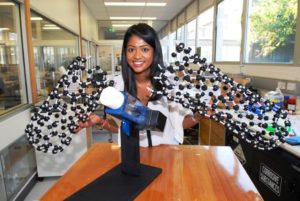
For more than forty years, the world has known the potential of carbon nanotubes; those minute, tubular cylinders of carbon atoms with extraordinary mechanical, electrical, thermal, optical and chemical properties.
With 200 times the strength and 5 times the elasticity of steel; 5 times the electrical conductivity, 15 times the thermal conductivity and 1,000 times the current capacity of copper – and with almost none of the environmental or physical degradation issues common to metals – they have been among the most exciting, but frustrating, materials in the world to effectively harness.
Now the world’s first carbon nanotubes cut to an average length of 170 nanometres using only water and a solvent, a laser and a device the size of a thermos flask are set to transform the world as you know it, for the better.
That’s according to a team of scientists led by Flinders University in Australia, who have published an article in Scientific Papers (Nature Publishing Group) showing how they can, for the first time, cut the holy grail of base materials in continuous flow, at a consistent length, without oxidisation and not using nasty chemicals.
It’s a development that is set to finally unlock the potential of one of the world’s strongest materials and open up countless applications for everything from next generation targeted cancer drugs, to more efficient solar panels, to new, super precise digital technologies.
The usual random sized lengths of entangled carbon nanotube created by other methods have so far allowed only relatively crude applications and constrained their use in drug delivery and complex electronics because of the resulting inability to guarantee consistent properties.
With his invention of the Vortex Fluidic Device (VFD) used by the research team to cut them into more precise lengths than ever before, Professor Raston at Flinders University has changed all that.
“Until now, the ‘revolution’ in technology predicted when carbon nanotubes were first created has been frustrated by our inability to accurately control their length. Our paper published today means the revolution is back on track,” says Professor Raston.
“That has been made possible by the VFD, which has lots of applications, ranging from unravelling proteins, to creating biofuel – to now untangling and cutting carbon nanotubes.
“In the case of carbon nanotubes, the way the liquid moves in the device is very complex, but the movement is important in the cutting.
“It’s a contradiction. To take an exceptional strong material and yet be able cut it in a liquid without heating, but that’s what the VFD can do.”
Flinders University PhD candidate Kasturi Vimalanathan, played a key role in developing the cutting process.
“We are now investigating the wide range of commercial possibilities for the precision-cut carbon nanotubes,” she says.
“Anyone who knows anything about carbon nanotubes will be incredibly excited by this development and will immediately understand what it means for a huge range of medical and technological applications.
“Having made those applications possible, Flinders University will now be working hard to stay at the centre of the new wave of technologies that we expect to flow on from this achievement.”
The new application of the device involved collaboration between Flinders University, Curtin University, the University of Cincinnati, the University of Missouri-Columbia, and ANSTO.

